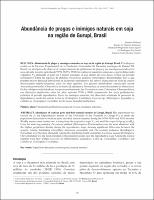| dc.description.abstract | El trabajo se realizó en la Estación Experimental de la Fundación Universidad de Tocantins, municipio de Gurupi-TO, Brasil, con el objetivo de observar el comportamiento de poblaciones de plagas y sus enemigos naturales en la soya, durante los años agrícolas de 97/98, 98/99 y 99/00. Se realizaron muestreos semanales, a partir del período vegetativo V2, utilizando el paño en 5 puntos escogidos al azar dentro del área, hasta el final del período reproductivo. Entre las especies de chinches, Piezodorus güildinii (Heteroptera, Pentatomidae) fue la que presentó mayor densidad poblacional en el período reproductivo del cultivo, alcanzando un nivel de control diferenciando significativamente entre los años agrícolas. Los gusanos desfoliadores encontrados fueron Anticarsia gemmatalis y Chrysodeixis includens (Lepidoptera: Noctuidae), en orden decreciente de abundancia. De los coleópteros desfoliadores, la especie predominante fue Cerotoma arcuata (Coleoptera: Chrysomelidae), con diferencia significativa entre los años agrícolas 97/98 y 99/00, presentando dos picos poblacionales próximos al período reproductivo. Entre los enemigos naturales, fue observada solamente la presencia de depredadores, siendo las arañas, Lebia sp. (Coleoptera: Carabidae), Geocoris sp. (Heteroptera: Lygaeidae) y Callidae sp. (Coleoptera: Carabidae) los de mayor densidad poblacional. This experiment was carried out at the Experimental Station of the University of the Tocantins in Gurupi-TO, to study the population fluctuation of soybean pests and their natural enemies during the 97/98, 98/99 and 99/00 seasons. Weekly surveys were carried out, starting from the vegetative stage V2, and until the stage of ripe grain (R8). From the stink bug complex, Piezodorus güildinii (Heteroptera: Pentatomidae) was the most abundant, with the highest population density during the reproductive stage, showing significant differences between the seasons. Among defoliating caterpillars, Anticarsia gemmatalis and Chrysodeixis includens (Lepidoptera: Noctuidae) were the most abundant. Among the defoliating beetle complexes, Cerotoma arcuata (Coleoptera: Chrysomelidae) was the most abundant, with population peaks near the reproductive stage. Among the natural enemies were they spiders, Geocoris sp. (Heteroptera: Lygaeidae), Lebia sp. (Coleoptera: Carabidae) and Callidae sp. (Coleoptera: Carabidae). | es_ES |


